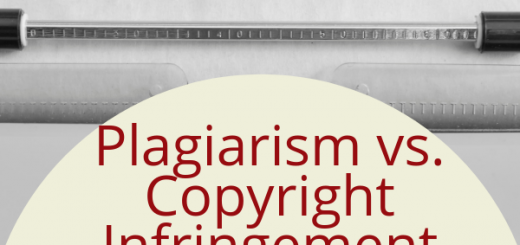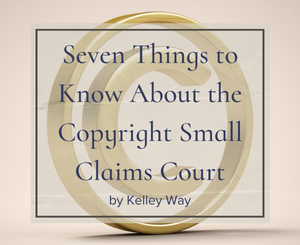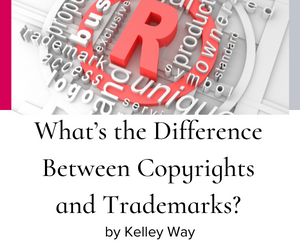All’s Fair in Love and War – But Not in Copyright Law by Kelley Way
Welcome to the weekly series on artist entrepreneurship. Today we focus on writers specifically and on an important tool for your empowerment, a topic of literary law — fair use — from our monthly guest columnist, Kelley Way, a lawyer specializing in literary law. If you have general questions for Kelley on contracts or other aspects of literary law, be sure to comment below. Thanks! PS. A list of books on literary law can be found here.
And now for a bit of necessary legalese: Please note that this article does not constitute legal advice, and that an attorney-client relationship is not formed by reading the article or by commenting thereon.
^*^
One of the questions I hear most frequently from authors is: When can I use someone else’s copyrighted material in my own work?[1]
Stories can’t be written in a vacuum, and many of the sources authors would like to draw on are copyrighted. As many copyright owners are ready to sue at the drop of a hat, it’s an excellent question to ask.
Generally, there are four answers:
1. The work has no copyright. Copyright only protects original, creative works of authorship. You can’t copyright a uniquely shaped rock you found while hiking; you didn’t create it. You also can’t copyright facts or ideas, only the way they are described or expressed (and even that is limited). So if you only want to use facts or data found in a copyrighted work, or want to use a single idea from said work, there is no copyright violation. In addition, government works are not copyrightable.
2. The copyright has expired. Any work published before 1923 is in the public domain – its copyright has expired. Anything created (not published) after January 1, 1978, the day the revamped Copyright Act went into effect, is copyrighted. Anything published in between those dates is uncertain – the copyright owner had to renew his or her copyright to keep it, so it may or may not still be copyrighted. Research would be required. Luckily, the old Copyright Act required authors to register with the Copyright Office when they published, so you at least know where to look.
3. The copyright owner gives permission. This is the safest route to go, particularly when you don’t know if your intended use of the work counts as infringement. However, permission typically comes with a price tag, so you’ll have to decide if you’d rather pay it or go without and risk a lawsuit. For example, if you want Mickey Mouse to appear in your children’s book, you had better get permission, because Disney defends its copyrights with an almost religious zeal. On the other hand, if you want to use the lyrics to the “Happy Birthday” song (which is copyrighted) in your novel, you might be able to get away with it, since the copyright owners rarely sue. Just remember that “rarely” does not mean “never,” and while a copyright owner may have never sued before, there’s always a first time for everything.
4. The fair use doctrine applies. The fair use doctrine exists to allow authors to use copyrighted material, in limited circumstances, without the permission of the copyright owner. The courts use a four-factor test, outlined below, to decide whether a use is fair. For an example, I’ll use Harper & Row v. Nation Enterprises, a major fair use case. In Harper, Harper & Row had agreed to publish former President Ford’s autobiography, and contracted with Time Magazine to write a prepublication story on it, using excerpts from the book. Nation Enterprises got hold of a copy of the book and wrote their own story, with excerpts, “scooping” Time Magazine. Time terminated the contract with Harper, and Harper sued Nation. The case went up to the Supreme Court, who used the four-factor test:
a. The purpose and character of the use. Courts look more favorably on an unauthorized use if it’s for a good cause. Criticism, comment, news reporting, teaching, research, and scholarship are presumptively fair uses. Commercial gain weighs against fair use. In Harper, the court found that the magazine used the article to sell copies, more than to report news, so this round went to Harper.
b. The nature of the copyrighted work. Copyright was designed to protect creative, artistic works, like fiction, music or art. These are given more protection than, for example, news reports or travel guides. This round went to Nation, since an autobiography relates facts and thus isn’t as strongly protected as a more creative work would be.
c. The amount used. This factor looks at both the quantity and quality of material taken from the copyrighted work. Nation’s excerpts from the book, while a small percentage of the overall text, centered around Ford’s decision to pardon Nixon, which the court determined was the “heart” of the book, because that was the part people would buy the book to read. As such, this round went to Harper.
d. The effect on the market. This is arguably the most important factor for the courts. If your use of the material would mean that people would buy your work instead of the original, or otherwise harm the original’s sales, fair use likely won’t apply. In Harper, Harper had already lost money from the cancellation of Time’s contract, so it won this round and the overall case. The same holds true of derivative markets; in a case where a rapper parodied “Pretty Woman,” using the song’s opening melody, the Supreme Court sent it back to the district court to determine whether the rapper’s song would act as a substitute for a rap version of “Pretty Woman,” should the copyright owner decide to make one. Remember, this only applies if your work would act as a substitute for the original; courts don’t care if your work makes the first one look so bad or unappealing that no one wants to buy it.
Fair use is great when it applies, but unfortunately you have to go to court to find out if it does; nothing is automatically fair use, and it is always decided on a case-by-case basis. As another lawyer once wisely said: “What does it mean to have a great defense? It means you’ve been sued!”
This article only scratches the surface of this topic, and hopefully provides some guidance to the many authors and publishers struggling with this issue. And remember, if in doubt – ask a lawyer. Their job is to know the law so you don’t have to.
[1] For the sake of simplicity, I’m falling back on some basic legal terms. In legalese, a “work” is anything that can be copyrighted (books, movies, songs, pictures, etc.). Likewise, an “author” is anyone who creates a work, not just a book author.
^*^
Kelley Way was born and raised in Walnut Creek, California. She graduated from UC Davis with a B.A. in English, followed by a Juris Doctorate. Kelley is a member of the California Bar, and an aspiring writer of young adult fantasy novels. She can be contacted at KelleyAWay@gmail.com.









This is a facinating way to look at law. Thanks, Kelley and Beth for this post.
I’m glad you liked it, and I hope you found it helpful. 🙂
What about quotes? My YA novel has a quote at the beginning of each chapter- as long as I say you said or wrote it can I use them or do I need to get permission?
Alica
Thanks for the great info on copyrighting. I do have a question though. Where can I find character release forms? Or contracts to use between writers working together on a writing project? Would it be acceptable to write up something of our own, or would it be important to have actual legal documentation? Thank you ahead of time for your help. I am definitely going to sign up for your newsletter.
Thanks again and Best,
S.K.Delph
Ahh, a tricky twist. You can’t copyright ideas, and can only protect ‘original ideas.’ Oh man, such a slippery slope since you could argue everything is derivative these days. What a waste of time and money it would be to sit through a copyright case on a book.
Alicia – assuming that the quote is taken from a copyrighted work, then the quote would be considered copyrighted material, and you should ideally get permission to use it.
S.K. Delph – Using a pre-made form is often helpful, but it’s not necessary. As long as you have on paper what the parties have agreed to, in exchange for what, with a date and the parties’ signatures, you have a valid contract. There are sites online that offer free legal forms, or you could go to a law library and ask the librarians to help you find the right treatise.
Jarvis – The bar for originality in copyrighted works is pretty low. The Supreme Court has said that a phonebook could be copyrighted, if the selection and arrangement of listings was “creative.” The only case I can recall where a work was found not original enough for copyright involved a photo of a plate of food at a Chinese restaurant.
Thanks for the comments, everyone!
This is a terrific article. It’s such a hazy area for many of us so I appreciate you taking the time to clear this up and put it in “layman’s terms”.
So glad it was helpful, Hugh. Kelley’s perspective is so useful. I’m grateful to have her writing for Writer’s Fun Zone.
Thanks Hugh! I’m glad you found this helpful.